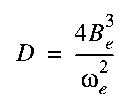The elastic rotor; centrifugal distortion
In an elastic rotor R is no longer constant but increases with increasing amount of rotation
as a result of centrifugal forces. This effect is known as centrifugal distortion.
An estimate of this effect can be obtained from a simple classical picture.
As the molecule stretches the centrifugal force Fc is,
at some new equilibrium distance Re',
balanced by the elastic binding force Fe, which is harmonic.
The centripetal and elastic forces are:

By equating Fc=Fe and by assuming it follows:

The expression for the rotational energy including the centrifugal effect is obtained from:

Now use Re' for the above equations and expanding the first term
of the energy expression it follows:

The quantum mechanical Hamiltonian is obtained by replacing N by the quantum mechanical operator.
It is clear that the spherical harmonics YNM(Omega)
are also solutions of that Hamiltonian.
The result for the rotational energy can be expressed as:

where:

is the centrifugal distortion constant.
This constant is quite small, e.g. 5.32 x 10-4 cm-1 in HCl,
but its effect can be quite large for high rotational angular momentum states
(N4 dependence).
Selection rules for the elastic rotor are the same as for the rigid rotor (see later).
 Last change: 18 February 2001
Last change: 18 February 2001






 Last change: 18 February 2001
Last change: 18 February 2001





